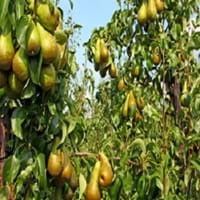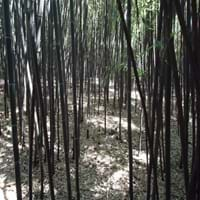Life Span
Perennial
Perennial
Origin
Western Europe
Southeastern Asia
Types
Pyrus amygdaliformis, Pyrus armeniacifolia, Pyrus bourgaeana
Clumping bamboo, Running bamboo, Umbrella bamboo
Habitat
Dappled Shade, Sunny Edge, Woodland Garden Secondary
Subtropical climates, Tropical regions
USDA Hardiness Zone
5-9
9-15
Sunset Zone
2a, 2b, 3a, 3b, 4, 5, 6, 7, 8, 9, 14, 15, 16, 17, 18
H1, H2, 18, 19, 20, 21, 22, 23, 24
Habit
Oval or Rounded
Clump-Forming
Minimum Width
Not Available
Flower Color
Not Available
Yellow green
Flower Color Modifier
Bicolor
Bicolor
Fruit Color
Not Available
Non Fruiting Plant
Leaf Color in Spring
Not Available
Green
Leaf Color in Summer
Not Available
Light Green
Leaf Color in Fall
Not Available
Green
Leaf Color in Winter
Light Green
Green
Leaf Shape
Oblong
Lance shaped
Plant Season
Spring, Fall
Spring, Summer, Fall, Winter
Sunlight
Full Sun, Partial Sun
Full Sun, Partial Sun
Growth Rate
Slow
Very Fast
Type of Soil
Loam
Loam, Sand
The pH of Soil
Acidic, Neutral
Acidic, Neutral, Alkaline
Soil Drainage
Well drained
Average
Bloom Time
Spring
Not Available
Tolerances
Drought
Cold climate, Drought, Salt
Where to Plant?
Ground
Ground
How to Plant?
Seedlings
Stem Planting
Plant Maintenance
Medium
Medium
Watering Requirements
Medium
Requires regular watering, Water more in summer
In Summer
Lots of watering
Lots of watering
In Spring
Moderate
Moderate
In Winter
Average Water
Average Water
Soil pH
Acidic, Neutral
Acidic, Neutral, Alkaline
Soil Type
Loam
Loam, Sand
Soil Drainage Capacity
Well drained
Average
Sun Exposure
Full Sun, Partial Sun
Full Sun, Partial Sun
Pruning
Remove crossing or rubbing branches, Remove damaged leaves, Remove dead branches, Remove dead leaves, Remove dead or diseased plant parts
No need to prune, Remove damaged leaves, Remove dead branches, Remove dead leaves
Fertilizers
All-Purpose Liquid Fertilizer
All-Purpose Liquid Fertilizer
Pests and Diseases
Red blotch
Aphids, Insects, Red blotch
Plant Tolerance
Drought
Cold climate, Drought, Salt
Flower Petal Number
Not Available
Single
Foliage Texture
Not Available
Fine
Foliage Sheen
Not Available
Matte
Attracts
Birds, Not Available
Aphids, Insects
Allergy
Itchiness, Mouth itching, Pollen, Sore Throat
no allergic reactions
Aesthetic Uses
Not Used For Aesthetic Purpose
Beautification, Showy Purposes
Beauty Benefits
Good for skin and hair
No Beauty Benefits
Environmental Uses
Air purification, Nesting sites for birds, Shadow Tree, Windbreak
Air purification
Medicinal Uses
Analgesic, Diuretic, Heart problems, High cholestrol, Stomach pain, Weight loss
No Medicinal Use
Part of Plant Used
Fruits, Wood
Stem, Tree trunks
Other Uses
Used as a dye, Used for woodware
Air freshner, Decoration Purposes
Used As Indoor Plant
No
Yes
Used As Outdoor Plant
Yes
Yes
Garden Design
Feature Plant, Fruit / Fruit Tree
Feature Plant, Tropical
Botanical Name
PYRUS 'Bosc'
BAMBUSA lako
Common Name
Bosc Pear, Pear
Black Timber Bamboo, Clumping Bamboo, Timor Black Bamboo
In Hindi
Bosc Pear Tree
तिमोर काला बांस
In German
Bosc Pear Tree
Timor-schwarzer Bambus
In French
Bosc Pear Tree
Timor bambou noir
In Spanish
Bosc Pear Tree
Timor Negro de bambú
In Greek
Bosc Pear Tree
Τιμόρ Μαύρο μπαμπού
In Portuguese
Bosc Pear Tree
Timor Black Bamboo
In Polish
Bosc Pear Tree
Timor Czarny Bambus
In Latin
Orbis Bosc ligno
Timor Niger Bamboo
Phylum
Magnoliophyta
Magnoliophyta
Class
Magnoliopsida
Liliopsida
Clade
Angiosperms, Eudicots, Rosids
Angiosperms, Commelinids, Monocots
Subfamily
Amygdaloideae
Barnadesioideae
Properties of Bosc Pear and Timor Black Bamboo
Wondering what are the properties of Bosc Pear and Timor Black Bamboo? We provide you with everything About Bosc Pear and Timor Black Bamboo. Bosc Pear doesn't have thorns and Timor Black Bamboo doesn't have thorns. Also Bosc Pear does not have fragrant flowers. Bosc Pear has allergic reactions like Itchiness, Mouth itching, Pollen and Sore Throat and Timor Black Bamboo has allergic reactions like Itchiness, Mouth itching, Pollen and Sore Throat. Compare all the properties and characteristics of these two plants. Find out which of these plant can be used as indoor plant. If you are interested to decorate your house and garden, find out aesthetic uses, compare them and select the plant which will beautify your surrounding. Along with beautification, try comparing medicinal and edible uses of Bosc Pear and Timor Black Bamboo and you can choose the plant having best and most benefits.
Season and Care of Bosc Pear and Timor Black Bamboo
Season and care of Bosc Pear and Timor Black Bamboo is important to know. While considering everything about Bosc Pear and Timor Black Bamboo Care, growing season is an essential factor. Bosc Pear season is Spring and Fall and Timor Black Bamboo season is Spring and Fall. The type of soil for Bosc Pear is Loam and for Timor Black Bamboo is Loam, Sand while the PH of soil for Bosc Pear is Acidic, Neutral and for Timor Black Bamboo is Acidic, Neutral, Alkaline.
Bosc Pear and Timor Black Bamboo Physical Information
Bosc Pear and Timor Black Bamboo physical information is very important for comparison. Bosc Pear height is 101.60 cm and width 38.10 cm whereas Timor Black Bamboo height is 1,520.00 cm and width Not Available. The color specification of Bosc Pear and Timor Black Bamboo are as follows:
Bosc Pear flower color: Not Available
Bosc Pear leaf color: Not Available
Timor Black Bamboo flower color: Yellow green
- Timor Black Bamboo leaf color: Green
Care of Bosc Pear and Timor Black Bamboo
Care of Bosc Pear and Timor Black Bamboo include pruning, fertilizers, watering etc. Bosc Pear pruning is done Remove crossing or rubbing branches, Remove damaged leaves, Remove dead branches, Remove dead leaves and Remove dead or diseased plant parts and Timor Black Bamboo pruning is done No need to prune, Remove damaged leaves, Remove dead branches and Remove dead leaves. In summer Bosc Pear needs Lots of watering and in winter, it needs Average Water. Whereas, in summer Timor Black Bamboo needs Lots of watering and in winter, it needs Average Water.





